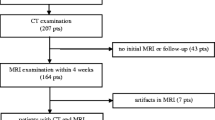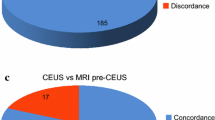Abstract
Introduction
Focal liver lesions (FLLs) are incidentally detected masses found in daily abdominal imaging which are necessary to be characterized, because of the potential of being malignant. There are several imaging methods, such as ultrasonography (US), computed tomography (CT scan), and contrast enhanced magnetic resonance imaging (MRI). Here, we evaluate and compare the diagnostic accuracy (i.e., sensitivity and specificity) of these imaging methods for the diagnosis of FLLs.
Material and Methods
In this retrospective study, patients with focal liver lesions included and based on the gastroenterologist decision, in 79 patients different imaging methods were used to determine the nature of FLLs: the US, CT scan, and MRI. At the next step, fine-needle aspiration biopsy (FNA) was performed in all cases, and the results about the true nature of FLLs compared with different imaging results. The chi-square test and McNemar test were used.
Results
Ultrasound diagnosis of benign and malignant was obtained with 82% diagnosis accuracy, 100% sensitivity, 71.4% specificity, 100% negative predictive value, and 69.2% positive predictive value (PPV) compared with the biopsy. Also, the results of benign and malignant masses in CT scan were obtained with diagnostic accuracy of 95%, 100% sensitivity, 80% specificity, 93.9% positive predictive value, and 100% negative predictive value. MRI performed only in 2 cases with similar results to pathology.
Conclusion
It seems that CT scan is more appropriate and useful in the diagnosis of hepatic masses due to its higher diagnostic accuracy than the ultrasound.

Similar content being viewed by others
References
Algarni AA, Alshuhri AH, Alonazi MM, Mourad MM, Bramhall SR. Focal liver lesions found incidentally. World J Hepatol. 2016;8(9):446–51. https://doi.org/10.4254/wjh.v8.i9.446.
Hassanipour S, Vali M, Gaffari-Fam S, Nikbakht H-A, Abdzadeh E, Joukar F, et al. The survival rate of hepatocellular carcinoma in Asian countries: a systematic review and meta-analysis. EXCLI J. 2020;19:108–30. https://doi.org/10.17179/excli2019-1842.
Hassanipour S, Mohammadzadeh M, Mansour-Ghanaei F, Fathalipour M, Joukar F, Salehiniya H, et al. The incidence of hepatocellular carcinoma in iran from 1996 to 2016: a systematic review and meta-analysis. J Gastrointest Cancer. 2019;50(2):193–200. https://doi.org/10.1007/s12029-019-00207-y.
Nasit JG, Patel V, Parikh B, Shah M, Davara K. Fine-needle aspiration cytology and biopsy in hepatic masses: A minimally invasive diagnostic approach. Clin Cancer Investig J. 2013;2(2):132.
de Sio I, Iadevaia MD, Vitale LM, Niosi M, Del Prete A, de Sio C, et al. Optimized contrast-enhanced ultrasonography for characterization of focal liver lesions in cirrhosis: a single-center retrospective study. United European Gastroenterol J. 2014;2(4):279–87.
Nazir RT, Sharif MA, Iqbal M, Amin MS. Diagnostic accuracy of fine needle aspiration cytology in hepatic tumours. J Coll Physicians Surg Pak. 2010;20(6):373–6.
Fornari F, Civardi G, Cavanna L, Buscarini L (1992) US-guided fine needle biopsy of focal liver lesions and hepatocellular carcinoma. In: Ultraschalldiagnostik’91. Springer, pp 229-231
Thimmaiah VT. Evaluation of focal liver lesions by ultrasound as a prime imaging modality. Sch J App Med Sci Ed. 2013;1(6):1041–59.
Machairas N, Papaconstantinou D, Gaitanidis A, Hasemaki N, Paspala A, Stamopoulos P, et al. Is single-incision laparoscopic liver surgery safe and efficient for the treatment of malignant hepatic tumors? a systematic review. J Gastrointest Cancer. 2020;51(2):425–32. https://doi.org/10.1007/s12029-019-00285-y.
Singal A, Volk M, Waljee A, Salgia R, Higgins P, Rogers M, et al. Meta-analysis: surveillance with ultrasound for early-stage hepatocellular carcinoma in patients with cirrhosis. Aliment Pharmacol Ther. 2009;30(1):37–47.
Friedrich-Rust M, Klopffleisch T, Nierhoff J, Herrmann E, Vermehren J, Schneider MD, et al. Contrast-enhanced ultrasound for the differentiation of benign and malignant focal liver lesions: a meta-analysis. Liver Int. 2013;33(5):739–55.
Torzilli G, Minagawa M, Takayama T, Inoue K, Hui AM, Kubota K, et al. Accurate preoperative evaluation of liver mass lesions without fine-needle biopsy. Hepatology (Baltimore, Md). 1999;30(4):889–93.
Piscaglia F, Lencioni R, Sagrini E, Dalla Pina C, Cioni D, Vidili G, et al. Characterization of focal liver lesions with contrast-enhanced ultrasound. Ultrasound Med Biol. 2010;36(4):531–50.
Anaye A, Perrenoud G, Rognin N, Arditi M, Mercier L, Frinking P, et al. Differentiation of focal liver lesions: usefulness of parametric imaging with contrast-enhanced US. Radiology. 2011;261(1):300–10.
Ryu SW, Bok GH, Jang JY, Jeong SW, Ham NS, Kim JH, et al. Clinically useful diagnostic tool of contrast enhanced ultrasonography for focal liver masses: comparison to computed tomography and magnetic resonance imaging. Gut Liver. 2014;8(3):292–7.
Hanna RF, Miloushev VZ, Tang A, Finklestone LA, Brejt SZ, Sandhu RS, et al. Comparative 13-year meta-analysis of the sensitivity and positive predictive value of ultrasound, CT, and MRI for detecting hepatocellular carcinoma. Abdom Radiol. 2016;41(1):71–90.
Scharitzer M, Ba-Ssalamah A, Ringl H, Kölblinger C, Grünberger T, Weber M, et al. Preoperative evaluation of colorectal liver metastases: comparison between gadoxetic acid-enhanced 3.0-T MRI and contrast-enhanced MDCT with histopathological correlation. Eur Radiol. 2013;23(8):2187–96.
Acknowledgments
The assistance and cooperation of the Health Deputy at the Gastrointestinal and Liver Diseases Research Center, Guilan University of Medical Sciences, who helped us in the data collection process are highly appreciated.
Funding
A substantial part of this study was supported by the Research Council of Guilan University of Medical Sciences
Author information
Authors and Affiliations
Corresponding author
Ethics declarations
Conflict of Interests
The authors declare that they have no conflict of interest.
Ethical Approval
This study was conducted in compliance with the provisions of the Helsinki Declaration. The study was approved by ethics committee of Guilan University of Medical Sciences.
Additional information
Publisher’s Note
Springer Nature remains neutral with regard to jurisdictional claims in published maps and institutional affiliations.
Rights and permissions
About this article
Cite this article
Alizadeh, A., Mansour-Ghanaei, F., Bagheri, F.B. et al. Imaging Accuracy in Diagnosis of Different Focal Liver Lesions: A Retrospective Study in North of Iran. J Gastrointest Canc 52, 970–975 (2021). https://doi.org/10.1007/s12029-020-00510-z
Published:
Issue Date:
DOI: https://doi.org/10.1007/s12029-020-00510-z




